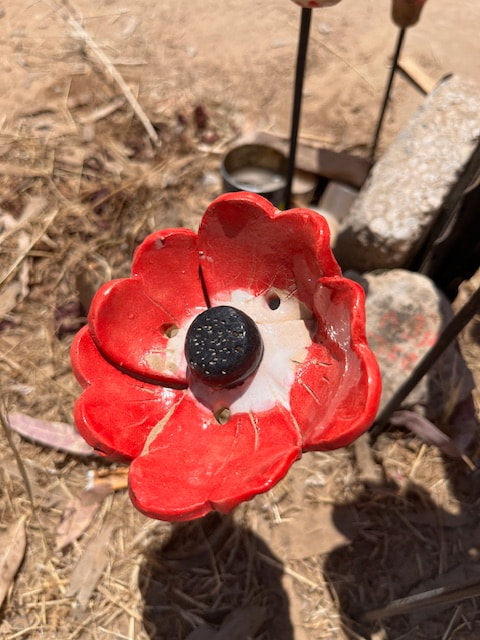|
In the days before I left for Israel, I began, in my sketchbook, to try my hand at drawing anemones. These red flowers are the national flower of Israel, but also represent the land and its people. The Hebrew word for this kind of flower is kalanit (kalaniot is plural).
It represents hope, resilience, and beauty.
I was struck by the many works of art I have seen online since Oct. 7 featuring peaceful kibbutz fields of red flowers. (Artists illustrate reactions to Oct. 7 at Jerusalem's Outline Festival | The Times of Israel).

Teaching myself to draw them was a way to begin turning my heart to the journey ahead. Kalaniot graced the park I used to pass when I lived in Jerusalem, and they stood out as part of the unique flora of the land.
In my days of travel on this trip, there were particular kalaniot that stood out. Unlike the blossoms that fluttered outside kibbutzim and in the parks of Jerusalem, these kalaniot were permanent. They were made to blossom throughout the seasons, a symbol of eternality in the face of incalculable endings.
They were part of the memorials that had been set up at the site of the Nova Music Festival.
|

One of hundreds of ceramic kalanit memorials at the Nova Music Festival site
|

One of hundreds of ceramic kalanit memorials at the Nova Music Festival site
|
|

One of hundreds of ceramic kalanit memorials at the Nova Music Festival site
When we arrived at the site of the Nova Music Festival. I recognized the trees from the film that Hillel at Muhlenberg hosted recently entitled, Supernova: The Music Festival Massacre (Supernova: The Music Festival Massacre (2023) - IMDb).
|

One of hundreds of ceramic kalanit memorials at the Nova Music Festival site
It was immediately apparent that we were on holy ground. Each victim was memorialized by a standing pole with their name and picture and a garden of ceramic kalaniot: the flowers of Israel that, here, would last forever. Some also has small gardens of stones, reflecting the Jewish custom of placing a stone at a gravesite when visiting.
|


























The site was crowded with many paying tribute, offering witness, and grieving. Some who were there at the same time as our group were clearly grieving close loved ones whose memorials stood before them. There were prayer groups, and visiting school and community groups. There were families and lone individuals. There were Jews and some non-Jews of all walks of life mourning and paying homage. Peppered throughout the site were art installations and memorials. Across the road was a nascent forest with a tree planted for each life that was taken that horrible day.
I spoke to a member of our group about her experience with this tragedy. She said she did in fact know one of the hostages--Hersh Polin-Goldberg--who was taken from the Festival. We believe he is still alive. The sorrow in this place is all too real.
Some of the faces on the memorials looked so much like my daughter. She is twenty-one, and had we been living in Israel would likely have found her way to this festival.
Being in the rarefied space, made sacred through unwilling sacrifice, I felt the heartbreak and the chill, despite the heat. I also saw the yearning, ever-more- urgent hope for those who were taken captive; for those we prayed were yet still alive.
We lacked words enough to meet the gravity of this place. All we could do was be present. We could witness.
I got separated from my group, lost in the wash of sorrow, weaving my way through the grounds. When I reunited with them, they were standing in a circle under some trees. One of our group, Cantor Jack Chomsky, was chanting El Maleh Rachamim (the prayer for the dead) with a depth and rich sadness I had never heard.
We Jews are blessed to have prayers to utter when we cannot find words of our own.
|

































